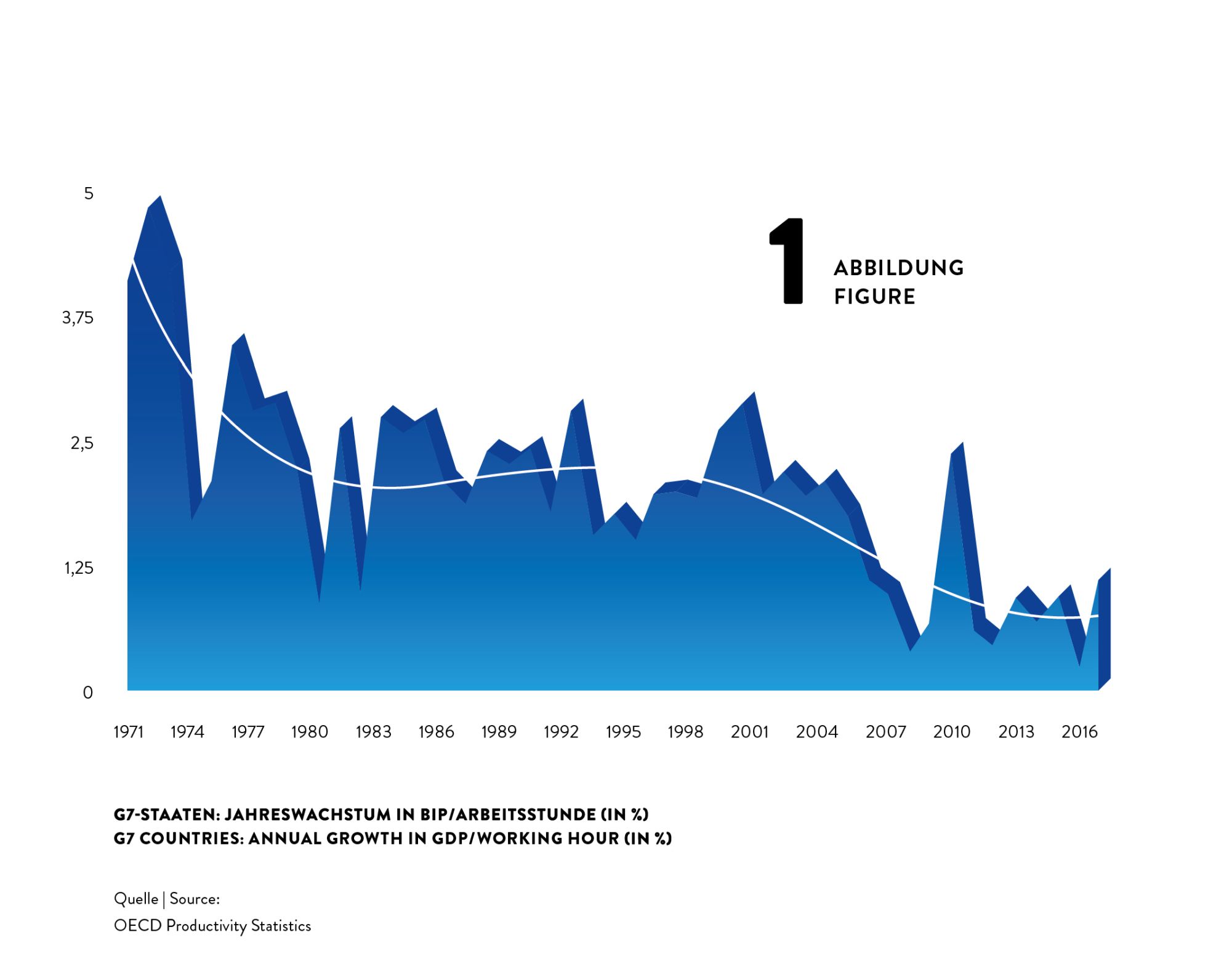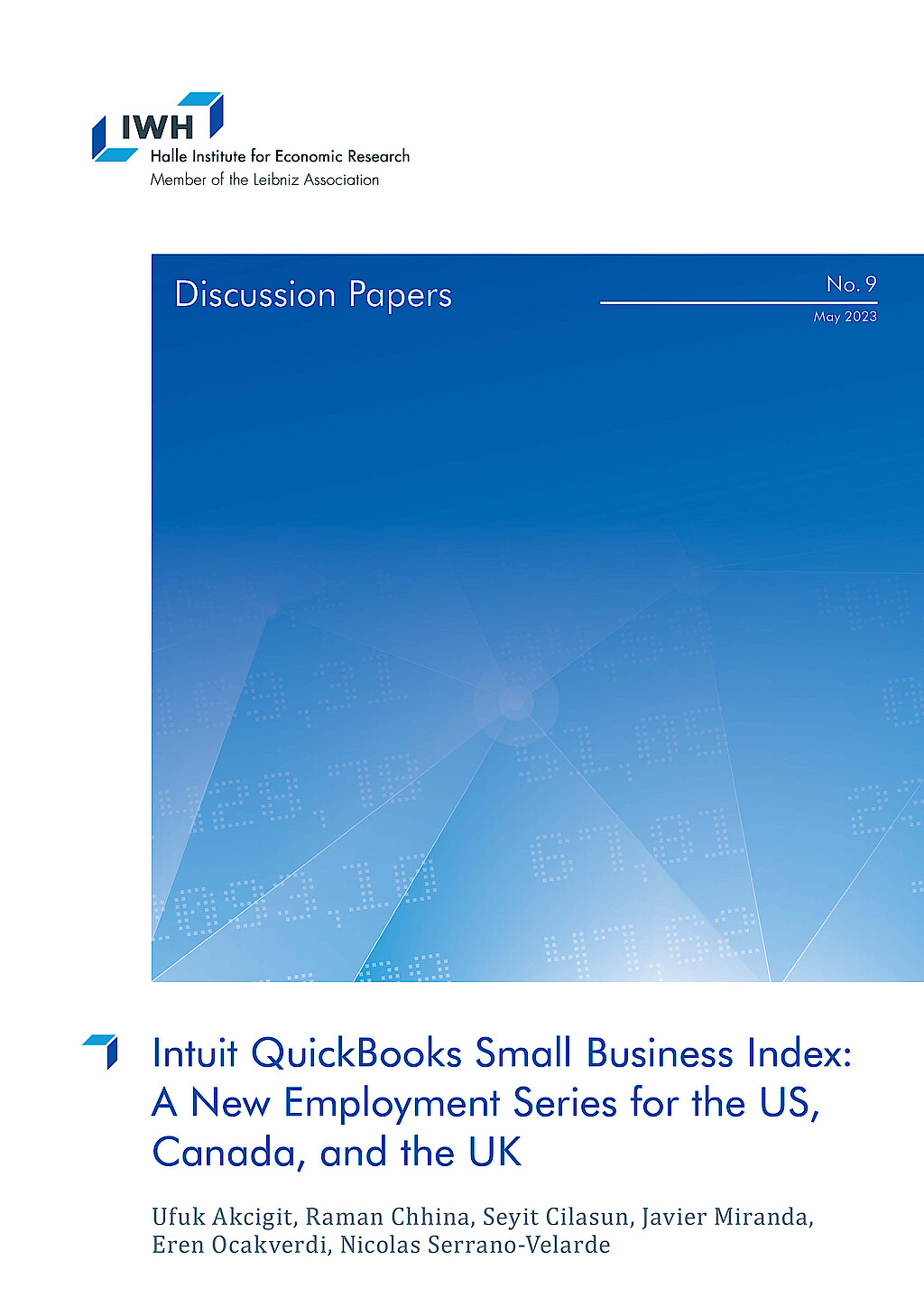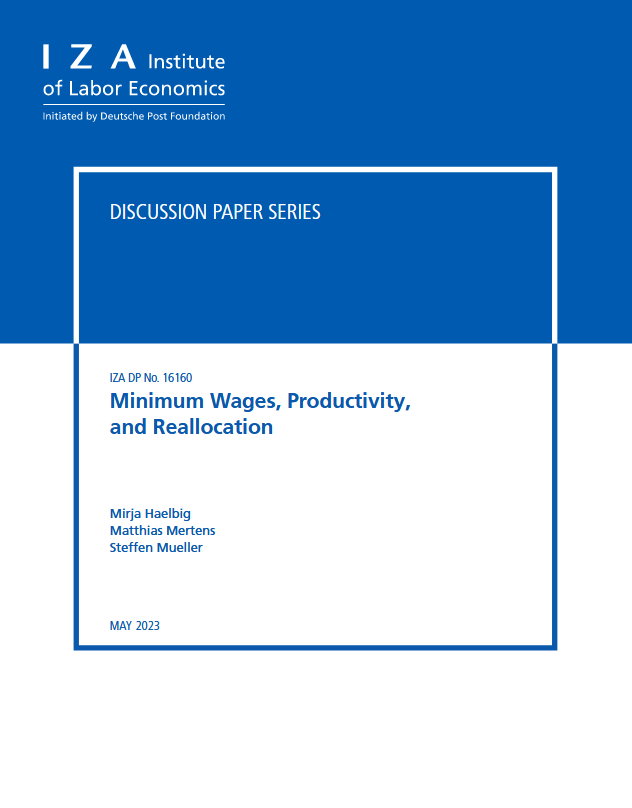Productivity: More with Less by Better
Available resources are scarce. To sustain our society's income and living standards in a world with ecological and demographic change, we need to make smarter use of them.
Dossier

In a nutshell
Nobel Prize winners Paul Samuelson and William Nordhaus state in their classic economics textbook: Economics matters because resources are scarce. Indeed, productivity research is at the very heart of economics as it describes the efficiency with which these scarce resources are transformed into goods and services and, hence, into social wealth. If the consumption of resources is to be reduced, e. g., due to ecological reasons, our society’s present material living standards can only be maintained by productivity growth. The aging of our society and the induced scarcity of labour is a major future challenge. Without productivity growth a solution is hard to imagine. To understand the processes triggering productivity growth, a look at micro data on the level of individual firms or establishments is indispensable.
Our experts

Department Head
If you have any further questions please contact me.
+49 345 7753-708 Request per E-Mail
President
If you have any further questions please contact me.
+49 345 7753-700 Request per E-MailAll experts, press releases, publications and events on “Productivity”
Productivity is output in relation to input. While the concept of total factor productivity describes how efficiently labour, machinery, and all combined inputs are used, labour productivity describes value added (Gross Domestic Product, GDP) per worker and measures, in a macroeconomic sense, income per worker.
Productivity Growth on the Slowdown
Surprisingly, despite of massive use of technology and rushing digitisation, advances in productivity have been slowing down during the last decades. Labour productivity growth used to be much higher in the 1960s and 1970s than it is now. For the G7 countries, for example, annual growth rates of GDP per hour worked declined from about 4% in the early 1970s to about 2% in the 1980s and 1990s and then even fell to about 1% after 2010 (see figure 1).

This implies a dramatic loss in potential income: Would the 4% productivity growth have been sustained over the four and a half decades from 1972 to 2017, G7 countries’ GDP per hour would now be unimaginable 2.5 times as high as it actually is. What a potential to, for instance, reduce poverty or to fund research on fundamentals topics as curing cancer or using fusion power!
So why has productivity growth declined dramatically although at the same time we see, for instance, a boom in new digital technologies that can be expected to increase productivity growth? For sure, part of the decline might be spurious and caused by mismeasurement of the contributions of digital technologies. For instance, it is inherently difficult to measure the value of a google search or another video on youtube. That being said, most observers agree that part of the slowdown is real.
Techno-Pessimists and Techno-Optimists
Techno-pessimists say, well, these new technologies are just not as consequential for productivity as, for instance, electrification or combustion engines have been. Techno-optimists argue that it can take many years until productivity effects of new technologies kick in, and it can come in multiple waves. New technology we have now may just be the tools to invent even more consequential innovations in the future.
While this strand of the discussion is concerned with the type of technology invented, others see the problem in that inventions nowadays may diffuse slowly from technological leaders to laggards creating a wedge between few superstar firms and the crowd (Akcigit et al., 2021). Increased market concentration and market power by superstar firms may reduce competitive pressure and the incentives to innovate.
Finally, reduced Schumpeterian business dynamism, i.e. a reduction in firm entry and exit as well as firm growth and decline, reflects a slowdown in the speed with which production factors are recombined to find their most productive match.
While the explanation for and the way out of the productivity puzzle are still unknown, it seems understood that using granular firm level data is the most promising path to find answers.
What are the Origins of Productivity Growth?
Aggregate productivity growth can originate from (i) a more efficient use of available inputs at the firm level as described above or (ii) from an improved allocation of resources between firms.
Higher efficiency at the firm level captures, e.g., the impact of innovations (Acemoglu et al., 2018) or improved firm organisation (management) (Heinz et al., 2020; Müller und Stegmaier, 2017), while improved factor allocation describes the degree of which scarce input factors are re-allocated from inefficient to efficient firms (‘Schumpeterian creative destruction’) (Aghion et al., 2015; Decker et al., 2021).
Most economic processes influence the productivity of existing firms and the growth and the use of resources of these firms and their competitors as well. The accelerated implementation of robotics in German plants (Deng et al., 2020), the foreign trade shocks induced by the rise of the Chinese economy (Bräuer et al., 2019), but also the COVID-19 pandemic, whose consequences are still to evaluate (Müller, 2021) not only effects on productivity and growth of the firms directly affected but at the same time may create new businesses and question existing firms.
While productivity can be measured at the level of aggregated sectors or economies, micro data on the level of individual firms or establishments are indispensable to study firm organisation, technology and innovation diffusion, superstar firms, market power, factor allocation and Schumpeterian business dynamism. The IWH adopts this micro approach within the EU Horizon 2020 project MICROPROD as well as with the CompNet research network.
As “creative destruction” may also negatively affect the persons involved (e. g., in the case of layoffs, Fackler et al., 2021), the IWH analyses the consequences of bankruptcies in its Bankruptcy Research Unit and looks at the implications of creative destruction for the society, e. g., within a project funded by Volkswagen Foundation searching for the economic origins of populism and in the framework of the Institute for Research on Social Cohesion.
Publications on “Productivity”

Import Competition and Firm Productivity: Evidence from German Manufacturing
in: World Economy, No. 8, 2023
Abstract
Abstract We study how different types of import competition affect firm productivity using firm-product data from German manufacturing (2000-2014). Competition from high-income countries causes affected domestic firms to increase their productivity and lower their prices. Oppositely, import competition from low-wage countries does not lead to firm productivity gains. Instead, domestic firms' sales and input usage decline. Our findings confirm the intuition of ladder models that the effect of competition depends on the "closeness" of competitors. They are in line with widespread X-inefficiencies throughout the economy, which firms reduce in response to competition from high-income countries.

Cross-country Evidence on the Allocation of COVID-19 Government Subsidies and Consequences for Productivity
in: Journal of the Japanese and International Economies, June 2023
Abstract
We study the consequences of the Covid-19 pandemic and related policy support on productivity. We employ an extensive micro-distributed exercise to access otherwise unavailable individual data on firm performance and government subsidies. Our cross-country evidence for five EU countries shows that the pandemic led to a significant short-term decline in aggregate productivity and the direct support to firms had only a limited positive effect on productivity developments. A thorough comparative analysis of the distribution of employment and overall direct subsidies, considering separately also relative firm-level size of support and the probability of being supported, reveals ambiguous cross-country results related to the firm-level productivity and points to the decisive role of other firm characteristics.

Intuit QuickBooks Small Business Index: A New Employment Series for the US, Canada, and the UK
in: IWH Discussion Papers, No. 9, 2023
Abstract
Small and young businesses are essential for job creation, innovation, and economic growth. Even most of the superstar firms start their business life small and then grow over time. Small firms have less internal resources, which makes them more fragile and sensitive to macroeconomic conditions. This suggests the need for frequent and real-time monitoring of the small business sector’s health. Previously this was difficult due to a lack of appropriate data. This paper fills this important gap by developing a new Intuit QuickBooks Small Business Index that focuses on the smallest of small businesses with at most 9 workers in the US and the UK and at most 19 workers in Canada. The Index aggregates a sample of anonymous Quick- Books Online Payroll subscriber data (QBO Payroll sample) from 333,000 businesses in the US, 66,000 in Canada, and 25,000 in the UK. After comparing the QBO Payroll sample data to the official statistics, we remove the seasonal components and use a Flexible Least Squares method to calibrate the QBO Payroll sample data against official statistics. Finally, we use the estimated model and the QBO Payroll sample data to generate a near real-time index of economic activity. We show that the estimated model performs well both in-sample and out-of-sample. Additionally, we use this analysis for different regions and industries. Keywords:

Minimum Wages, Productivity, and Reallocation
in: IZA Discussion Paper, No. 16160, 2023
Abstract
We study the productivity effect of the German national minimum wage by applying administrative firm data. At the firm level, we confirm positive effects on wages and negative employment effects and document higher productivity even net of output price increases. We find higher wages but no employment effects at the level of aggregate industry × region cells. The minimum wage increased aggregate productivity in manufacturing. We do not find that employment reallocation across firms contributed to these aggregate productivity gains, nor do we find improvements in allocative efficiency. Instead, the productivity gains from the minimum wage result from within-firm productivity improvements only.

The Characteristics and Geographic Distribution of Robot Hubs in U.S. Manufacturing Establishments
in: American Economic Association Papers and Proceedings, May 2023
Abstract
We use establishment-level data from the US Census Bureau's Annual Survey of Manufactures to study the characteristics and geographic locations of investments in robots. We find that the distribution of robots is highly skewed across locations. Some locations, which we call Robot Hubs, have far more robots than one would expect even after accounting for industry and manufacturing employment. We characterize these Robot Hubs along several industry, demographic, and institutional dimensions. The presences of robot integrators, which specialize in helping manufacturers install robots, and of higher levels of union membership are positively correlated with being a Robot Hub.



